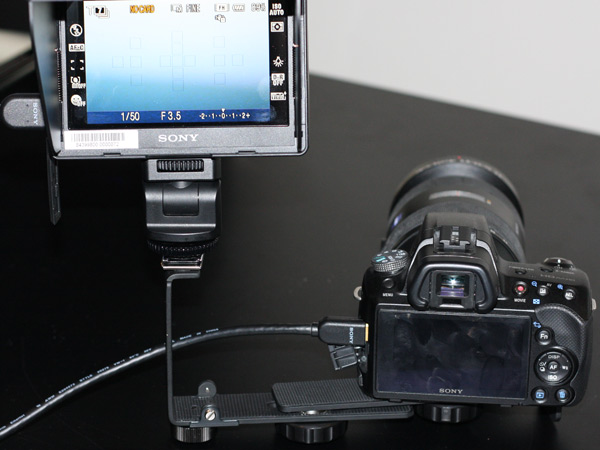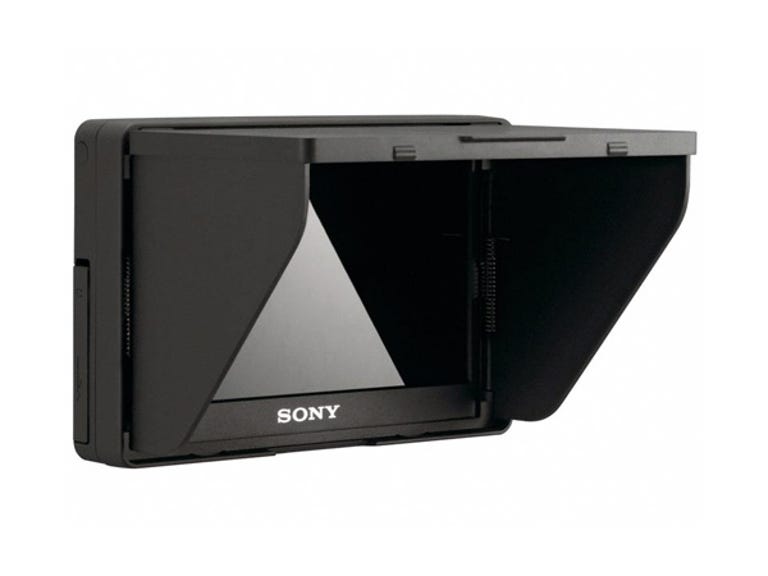 Why You Can Trust CNET
Why You Can Trust CNET Sony CLM-V55 review: Sony CLM-V55
This incredibly useful LCD monitor makes all the difference for photographers, offering audio monitoring and 5 inches of high-resolution screen real estate. Bonus points for being compatible with any camera with HDMI output.
Imagine a world where screen real estate goes beyond 3 inches or 3.2 inches on your digital camera. It's not really possible when cameras, and especially interchangeable lens cameras (ILCs), are being made so small, but the CLM-V55 LCD monitor changes all of that. It's a 5-inch screen offering a WGA-resolution (800x400) display for reviewing and recording photos and videos, connecting to any camera via HDMI, with a mono speaker on the back.
The Good
The Bad
The Bottom Line
Unfortunately, there's no easy way to mount the screen on Sony's own NEX series of ILCs, apart from the NEX-7, given that they use a proprietary flash mount. The only way to get around this limitation would be to use a mounting bracket attached to the tripod socket, or a third-party hotshoe adapter that converts the proprietary NEX mount into a regular cold shoe. The only example we've come across so far is this hack from Wide Open Camera.

The V55 attached to a Sony Alpha digital SLR.
(Credit: CBSi)
The screen displays all of the same information found on the camera's LCD, and it's as simple as plugging in the included cable for HDMI to mini-HDMI to the appropriate ports, and switching both the camera/camcorder and screen on. In the box, the V55 also comes with two accessory shoe adapters for mounting the screen on a cold shoe. Using one of the adapters, the screen can tilt forwards and backwards up to 90 degrees, and can swivel 360 degrees. There's also a detachable hood that's ideal for using outdoors and in bright situations. It folds neatly back on itself with side flaps and a hood when not in use.
Most importantly, the V55 addresses another big issue facing filmmakers using SLRs or ILCs: audio monitoring. There's a 3.5mm headphone jack just above the HDMI input, which helps to monitor sound recording through the camera's microphone or external microphone, if applicable.
A push dial on the side brings up the following functions on the right side of the screen: peaking; pixel magnification; TV-display area in 16:9 or 4:3; volume adjustment; brightness; contrast; colour tone; backlight; and colour-temperature adjustments for the screen. The pixel-magnification feature displays the centre portion of what the image sensor sees at WVGA resolution.
Performance
The V55 excels when used in any situation where more screen real estate is valuable. For shooting video in particular, the screen offers a very good, colour-accurate way of monitoring the frame. The screen is reflective, which may affect use in situations with lots of ambient light. It is, however, reasonably easy to see in bright sunlight.
All that said, the screen doesn't work seamlessly with all cameras; it depends on how the camera outputs its signal through HDMI. For example, on the Canon 5D Mark II, the output display doesn't fill the V55's screen — you're left with black borders. You can work around it by using the pixel-magnification feature, but it then crops in even further on the centre of the image, and cuts off details at the sides of the frame that you may need to see. Audio monitoring also doesn't work in real time when Live View is activated on the Canon, unlike on other ILCs, such as the NEX and Nikon 1 camera that we tested in conjunction with the V55.
Depending on the battery mounted on the back of the screen — it's compatible with three juice packs — it can be powered for up to eight hours.
Conclusion
The V55 has some drawbacks for serious videographers, but, for anyone wanting a bit more screen for their camcorder or camera, it's an excellent investment that adds peaking and audio monitoring to an existing configuration.


